|
|
 |

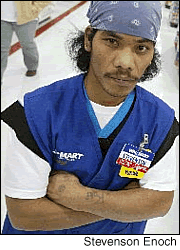 Stories
by Christopher Leonard Stories
by Christopher Leonard
Photographs by Benjamin Krain
In the remote Marshall Islands, residents
dream and save for years for a new life in Arkansas.
Dainah Amram remembers when her son Stevenson
was a little boy who slept snuggled in the crook of her arm. In
the small cinder-block shack on the Majuro atoll where he was raised,
only memories remain of Stevenson. Three years ago, Amram borrowed
$2,000 to send her son away.
It’s unclear if he will ever return.
The loan bought Stevenson a one-way plane ticket to the United States,
where he eventually settled in Springdale, Ark. For a year and a
half, Amram spent more than half of her wages to repay the debt.
She says it was worth the cost.
“I saved his life,” Amram said.
Her son, she explains, was saved from an empty future in the neighborhood
outside her window. White streets of crushed shell and coral narrowly
divide clusters of plywood and cinder-block homes, few of which
have running water.
Thousands of Marshall Islanders like Stevenson now live in Springdale.
This is the story of their past, their present and perhaps their
future as they become Arkansans.
The Majuro atoll is the capital of the Republic of the Marshall
Islands, a nation of hundreds of small islands flung across thousands
of square miles of Pacific Ocean.
From the air, Majuro looks like an impossibly thin ribbon of green,
marooned in a world of blue. Atolls are formed by coral reefs that
grow upon the remnants of ancient, submerged volcanoes. After eons,
the atolls form as rings of narrow islands and islets surrounding
sapphire-blue lagoons.
For time out of memory, the Marshallese survived on these strips
of land by fishing in the atolls’ lagoons and gathering fruit.
When the U.S. Navy took control of Majuro in 1944, the sailors encountered
roughly 1,000 people living in thatched huts and lush jungle.
The population on Majuro now is 23,700 or more, thanks to the largess
of Americans who have subsidized the islands with hundreds of millions
of dollars. Imported food sustains a population that far exceeds
the islands’ resources.
Most of the islanders live in crowded neighborhoods like Amram’s,
with an average of eight people to a house.
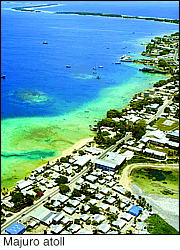 In
many ways, Majuro is like an enormous waiting room whose residents
are stuck between two worlds, having abandoned their old culture
for a modern life that has yet to materialize. In
many ways, Majuro is like an enormous waiting room whose residents
are stuck between two worlds, having abandoned their old culture
for a modern life that has yet to materialize.
Every week people move to Majuro or Ebeye, the Marshall Islands’
other urbanized island, abandoning lush outer islands where traditions
have sustained them for generations. The densely packed neighborhoods
of Majuro and Ebeye largely have been stripped of vegetation. The
inhabitants live in a cash economy.
Trading Micronesian tradition for modernity has come at a cost for
young men like Stevenson Enoch, Amram’s son, who uses his father’s
last name. Their choices are few.
A recent Marshall Islands government report said there are only
85 more jobs in the islands than there were a decade earlier. But
there were 3,189 more people seeking jobs. Alcoholism is more common
than lucrative employment. The suicide rate is among the highest
in the world.
The Marshall Islands’ population has soared in the past half-century
— it was just 14,163 in 1958 and reached 30,873 in 1980, according
to census records. Now it’s about 58,000.
Springdale has become an escape valve for the Marshallese. The small
industrial city is host to the largest population of Marshall Islanders
outside of the home islands.
Many islanders call Springdale the “land of opportunity,”
probably unaware that Arkansas license plates once carried that
slogan.
Marshallese immigrants benefit from extraordinarily close ties to
the United States that were codified when the countries signed the
Compact of Free Association in 1986, when the islands gained their
independence. Marshallese are allowed to live and work in the United
States indefinitely without visas. As a result, few of those who
immigrate seek U.S. citizenship.
Enoch, 27, was hard at work just before dawn recently, finishing
his nine-hour shift at the Wal-Mart Supercenter in Springdale. His
journey of 6,000 miles led him to the shredded-cheese section of
the store, where he stocks shelves.
Dressed in baggy jeans and a T-shirt, he opened small boxes full
of cheese packets. He held them up for comparison against a display
where more than 100 varieties of cheese hung. Then he matched the
package labels to those on the wall and hung them there in bunches.
Enoch says he makes $8 an hour. That’s quadruple his mother’s
pay. On the rare occasion when he calls her, she asks him if he
will return. He says no. He thinks he would likely end up unemployed
and living in his mother’s home.
“I won’t go back and let her work for me,” he said.
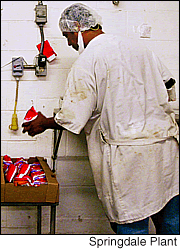 Thousands
of Marshallese have made the same choice. Working in chicken plants,
factories and fast-food restaurants, they enjoy a lifestyle that
only a few could afford back home. In Springdale public schools,
their children get a better education than most of the top-ranked
private-schools’ students on the islands. Thousands
of Marshallese have made the same choice. Working in chicken plants,
factories and fast-food restaurants, they enjoy a lifestyle that
only a few could afford back home. In Springdale public schools,
their children get a better education than most of the top-ranked
private-schools’ students on the islands.
It’s unclear exactly how many Marshall Islanders call Springdale
home. A special U.S. Census Bureau survey in 2001 indicated that
there were 2,000 to 6,000 of the islanders in Springdale, a city
that then had about 46,000 residents.
Since that survey, the influx has continued, islanders say. In the
Springdale School District, the number of children speaking Marshallese
as a first language grew from 226 in 2000 to 623 this fall.
Yet, the Marshallese often go unnoticed in Springdale, overshadowed
by the 23,500 Hispanics who arrived in Northwest Arkansas during
the 1990s. Many Marshallese say it’s not uncommon for them
to be mistaken for immigrants from Mexico or Central America.
Springdale resident Debbie McCarty says she assumed that the immigrants
working with her at the Bentonville Plastics factory were “all
Mexicans.” Then she noticed something odd about them —
they didn’t wear shoes on the factory floor. Bosses let them
put mesh coverings on their feet. McCarty asked around and discovered
that they were islanders who go barefoot while inside, according
to their custom.
Virtually everyone in the Marshall Islands has heard of Arkansas.
Opinions about faraway Springdale vary widely. Some people dream
of one day going there. Others believe that their migrant brethren
have abandoned their culture.
But few Marshallese are untouched by the Arkansas community, regardless
of what they think of it. Moses Alik, for example, says he will
never move to Arkansas. He lives and works on Majuro and doesn’t
want to leave his home and family.
Nonetheless, when presented a baseball cap bearing the University
of Arkansas logo, Alik flashed a big smile and exclaimed: “Razorback!”
Back To Top
LONG ROAD TO SPRINGDALE
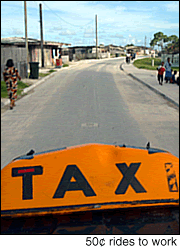 The
streets of Majuro begin to stir just after sunrise. Dented, dusty
taxicabs troll up and down the main road, gathering residents for
their 50-cent rides to work. The
streets of Majuro begin to stir just after sunrise. Dented, dusty
taxicabs troll up and down the main road, gathering residents for
their 50-cent rides to work.
A woman in a brown dress pushes a wheelbarrow
full of garbage across the road, toward a large orange bin already
brimming with the neighborhood’s trash. She wedges her load
next to the large bin and piece by piece heaves her refuse over
the side. Beyond her, waves roll in from the Pacific, stroking the
beach in a steady rhythm.
Across the street, another family starts its day in a cluster of
shacks surrounded by a wall of corrugated tin. Three girls, perhaps
10 years old, squat around a bucket full of water in a courtyard.
They take turns dipping a cup, pouring water over their heads and
splashing their faces.
It is a safe bet at this time of morning that Gordon Bellu will
be somewhere nearby, already hard at work. Wiry and energetic, Bellu
is manager of two gas stations owned by one of the islands’
larger companies, Robert Reimers Enterprises. Frequently, he crosses
the main road to check on the properties, a walkie-talkie in his
hand and a cell phone clipped to his belt.
Bellu puts in 12-hour days with one goal in mind — moving his
family to Arkansas. His sister lives in Springdale and tells him
stories about high-paying jobs and great public schools. He wants
his two children to get an education there and avoid the kind of
life he has lived on Majuro.
The long road to Springdale is steeply uphill for Marshallese like
Bellu. Their wages are far lower than those of their counterparts
in Arkansas. At the same time, the consumer goods they buy are more
expensive because they are shipped from abroad. A 12-ounce can of
Spam, an island favorite, sold on Ebeye island recently for $4.
At a Wal-Mart in Springdale, a can costs $1.90.
 One-way
airfare to Arkansas costs around $1,500, a small fortune for someone
who earns $2 an hour — the minimum wage on the islands. Many
Marshallese take out loans for the trip and send one family member,
who then works in Springdale and saves money to bring the next relative.
Bellu wants to take a different route. “I don’t want to
leave some behind. My kids are not old enough to take care of themselves,
and my wife — I don’t want to leave her. I want us all
to go,” he said. One-way
airfare to Arkansas costs around $1,500, a small fortune for someone
who earns $2 an hour — the minimum wage on the islands. Many
Marshallese take out loans for the trip and send one family member,
who then works in Springdale and saves money to bring the next relative.
Bellu wants to take a different route. “I don’t want to
leave some behind. My kids are not old enough to take care of themselves,
and my wife — I don’t want to leave her. I want us all
to go,” he said.
Bellu has avoided many of the pitfalls that keep some Marshallese
penniless. He swore off alcohol 11 years ago because it was too
expensive. He has won four promotions in four years, going from
sales clerk to manager. He earns an unusually high $5 an hour.
Every two weeks, he manages to sock away $25 in a savings account
that he hopes will get him to Arkansas. At last word, he had saved
roughly $800. He dips into the account every now and then to buy
school supplies or food for his children. “That’s why
it goes so slow,” he said with a laugh.
While the Republic of the Marshall Islands is one of the more remote
places on the globe, it has a close relationship with the United
States that is almost unparalleled. Marshallese serve in the U.S.
armed forces. There is a U.S. post office on Majuro, and the country
has a ZIP code and uses the American dollar.
This relationship started during World War II when American soldiers
captured the Marshall Islands from the Japanese, who had ruled them
for 30 years. More than 600 U.S. Marines, airmen and sailors lost
their lives in several battles across the islands; the Japanese
suffered thousands of casualties.
The U.S. government administered the islands after the war as a
trust territory for the United Nations, until they gained independence
in 1986. The Americans built schools and roads and sent bureaucrats
to run it all, said Robert Kiste, an anthropologist who has studied
the islands for 40 years. The United States’ interest in the
islands was purely strategic because of their location and remoteness,
Kiste said.
“That was the only reason the U.S. would even agree to [having]
a trust territory,” Kiste said. “It was strategic and
remains that way.” The right of “strategic denial”
allows the United States to control which ships pass through 750,000
square miles of ocean around the islands.
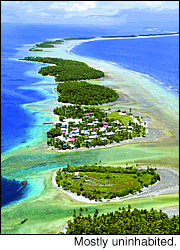 The
main island of Kwajalein atoll, the largest atoll in the world,
is home to a U.S. Army base that includes the Ronald Reagan Ballistic
Missile Defense Site, a critical component of efforts to build a
missile defense shield. The same remoteness that allows missile
testing played another role in history. On the morning of July 1,
1946, an enormous mushroom cloud rose over the Bikini atoll in the
northwest corner of the Marshall Islands. Over the next 12 years,
the United States detonated 67 atomic or hydrogen bombs in the area.
The tests cost the islanders dearly. Residents of Bikini and nearby
atolls were relocated to other islands and still live in a kind
of exile. Bikini remains uninhabited. The
main island of Kwajalein atoll, the largest atoll in the world,
is home to a U.S. Army base that includes the Ronald Reagan Ballistic
Missile Defense Site, a critical component of efforts to build a
missile defense shield. The same remoteness that allows missile
testing played another role in history. On the morning of July 1,
1946, an enormous mushroom cloud rose over the Bikini atoll in the
northwest corner of the Marshall Islands. Over the next 12 years,
the United States detonated 67 atomic or hydrogen bombs in the area.
The tests cost the islanders dearly. Residents of Bikini and nearby
atolls were relocated to other islands and still live in a kind
of exile. Bikini remains uninhabited.
Hundreds of residents of the Rongelap atoll were exposed to radioactive
fallout when the United States detonated a hydrogen bomb near Bikini
in 1954. Dozens died of cancer and other diseases. Rongelap remains
largely uninhabited and contaminated with radiation. The United
States has paid hundreds of millions of dollars to compensate the
Marshallese for the atomic testing, including for cancer deaths
believed to have been caused by the radiation.
All of this paved the way for the Republic of the Marshall Islands
to remain intertwined with the United States after it attained independence.
Tony DeBrum, one of the chief Marshallese negotiators of the Compact
of Free Association, said immigration rights was a cornerstone of
the agreement. His hope was that the rights would pave the way to
opportunity that his government couldn’t offer.
“I think the story of Springdale is a crowning jewel in that
hope,” he said.
Back To Top
FOUNDING FATHER
 The
thousands of islanders living in Springdale can trace their passage
directly to one man — John Moody. The
thousands of islanders living in Springdale can trace their passage
directly to one man — John Moody.
Moody recently returned home from working the
night shift at a Tyson Foods plant in Clarksville and plopped down
on a couch in his mobile home in the nearby town of Altus. He was
the first Marshall Islander to move to Springdale and inadvertently
created the immigrant community.
“I said, if they want a better life, they better come here.
So I start bringing them over, little by little. All those people
I brought, they still live there today,” he said. “I thought
they would go back home,” he continued, smiling as if the whole
thing seemed too strange. “I didn’t know that they would
bring their neighbors and their friends and their brothers and their
sisters.”
Moody fulfilled a lifelong dream when he moved to the United States
in 1979 with a scholarship to attend the University of Oklahoma.
But his schooling in the Marshall Islands didn’t equip him
for college classes, he said. He spent more time boning up on his
English than completing his homework.
A friend of Moody’s suggested that they work in a chicken plant
in Muskogee, Okla. The pay was $3.25 an hour — a fortune in
Moody’s eyes, though just a little above minimum wage at the
time. He dropped out of college and started working full time. Around
1986, Moody moved to Springdale, where he eventually got a job with
Tyson Foods.
Around that time, there were Marshallese communities scattered throughout
the United States. Interviews with dozens of islanders indicate
that most of the communities started when the people arrived there
to attend school on scholarships as Moody had done. The main communities
that remain today are in Honolulu; Enid, Okla.; Costa Mesa, Calif.;
and Portland, Ore. The second-largest community after Springdale
is in Hawaii. The populations of most of the other communities are
estimated to be in the hundreds. Increasingly, Springdale is the
place to be.
Moody urged his relatives to move to Springdale during the 1990s,
talking up the schools and jobs. It wasn’t a hard sell, since
the unemployment rate on the Marshall Islands grew from 12.5 percent
in 1988 to 30.9 percent in 1999.
 Springdale,
meanwhile, was experiencing a boom in industrial jobs at chicken
plants and other factories where English skills weren’t a necessity.
Step by step, Springdale became a sweet spot for Marshallese pursuing
a new life in America. While there were plentiful jobs elsewhere,
Springdale also offered a low cost of living and a slower pace.
In the tightly knit community of islanders, word spread fast about
Springdale’s advantages. Springdale,
meanwhile, was experiencing a boom in industrial jobs at chicken
plants and other factories where English skills weren’t a necessity.
Step by step, Springdale became a sweet spot for Marshallese pursuing
a new life in America. While there were plentiful jobs elsewhere,
Springdale also offered a low cost of living and a slower pace.
In the tightly knit community of islanders, word spread fast about
Springdale’s advantages.
Paul Lang, a native of the islands, left Costa Mesa when he heard
about land prices in Springdale. He now owns a house in the Arkansas
city. “They cannot afford to rent those houses over there,”
he said, referring to California. “Right now, a two-bedroom
is like $1,000-something a month.”
Lang’s Marshallese neighbors open their garage doors on warm
sunny days to reveal improvised living rooms where men and women
lounge on couches. Children roam from home to home as if they all
belong to one family.
On Springdale’s congested highways, a large number of cars
have tall CB radio antennas. The radios are popular with Marshallese
who use them to communicate just as they do back home where telephone
service is unreliable. They have a CB radio group called “Big
Yokwe” – “Big Hello.”
Among the new subdivisions in Springdale, houses here and there
have shoe racks on front porches piled high with flip-flops and
work boots, a sure sign of Marshallese within. Lang said some problems
arose in the early days of the Marshallese community. The first
immigrants weren’t aware of U.S. private property rights. Some
islanders drank heavily on the weekends and ended up on the wrong
side of the law when they passed out in neighbors’ yards, he
said. Most behavior like that soon stopped.
Brian Simmons, spokesman for the Springdale Police Department, said
the Marshallese are a law-abiding lot who haven’t put a strain
on the city’s law enforcement officers. Since most Marshallese
in Springdale are bilingual, the police haven’t hired any translators.
“I think that they are probably a little quieter than what
you would expect,” Simmons said. “They really appear to
me to be a group of people that don’t like trouble.”
The Marshallese are on the lower economic rungs of Springdale’s
work force. During the night shift at Tyson Foods’ Randall
Road plant, about half of the workers are islanders. They are also
common on the factory floor of Rockline Industries, which makes
baby wipes and scented tissues.
There are slightly more men than women among the Marshallese in
Springdale, according to the 2001 special census. The survey indicated
that men and women alike get jobs when they arrive in Arkansas,
and 77 percent of the population above age 16 is in the work force.
Neighbors watch over one another’s children while parents work.
The trailblazer for the islanders has moved on. Moody said he chose
to work in Clarksville and live in Altus because Springdale became
too crowded. He still gets calls from new residents in Springdale
who are trying to figure out where to get a driver’s license
or buy a whole pig to roast for parties.
“I don’t even know them,” he said. “They know
my name, though.”
Back To Top
A KING IN LITTLE MAJURO
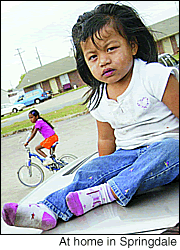 Stevenson
Enoch recently ended his shift around 7 a.m. and walked out of Wal-Mart
into a misty rain. Clouds on the horizon had just started to redden
with the dawn. In some ways, the landscape Enoch saw is similar
to that of his home island. Springdale’s one-story strip malls
and stores form a jagged low skyline not unlike Majuro’s main
street. Stevenson
Enoch recently ended his shift around 7 a.m. and walked out of Wal-Mart
into a misty rain. Clouds on the horizon had just started to redden
with the dawn. In some ways, the landscape Enoch saw is similar
to that of his home island. Springdale’s one-story strip malls
and stores form a jagged low skyline not unlike Majuro’s main
street.
Differences are apparent. The Wal-Mart parking lot appeared larger
than the grounds of the Marshall Islands Capitol. The cars and buildings
are luxurious compared with those on Majuro. Enoch got into his
car and drove toward U.S. 412, a traffic-snarled four-lane road
bordered by factories, shopping centers and a few grassy fields.
Springdale has been a hub of blue-collar and agricultural jobs since
the 1880s, said Brooks Blevins, an Ozarks historian. Apple orchards
created a boom that was later replaced by poultry farming. The city
is now home to Tyson Foods, the world’s biggest meat company,
0along with smaller poultry firms like George’s Inc.
Springdale isn’t a tourist destination, but it long has drawn
foreign-born workers like the Marshallese, said Susan Young, outreach
director for the city’s Shiloh Museum. “It’s kind
of reflective of what people did in the pioneer days,” Young
said. “You’d get here and write letters home saying: ‘Man,
you need to come to Northwest Arkansas. It’s the land of milk
and honey.’ That leads to these chain migrations. They come
here for jobs first, quality of life second.”
The Marshallese in Springdale were helped by the earlier, larger
wave of arriving Hispanics. The Spanish-speaking immigrants not
only attracted far more attention — or criticism, in some cases
— they gave public agencies experience in dealing with new
residents who didn’t speak English.
While most of the islanders are bilingual, they sometimes need help
dealing with complex issues in English. The Washington County unit
of the state Department of Health has at least five full-time Hispanic
translators and has added one for the Marshallese. At Springdale
public schools, the English as a Second Language program hired a
Marshallese tutor in 1997 when the need became apparent.
The Jones Center for Families, a public community center in downtown
Springdale, has become a second home for many islanders. They celebrate
the birth of their nation there with a festival organized by their
own civic group, commemorating May 1, 1979, when the country’s
constitution was signed, and Oct. 21, 1986, when full independence
was gained. The event draws thousands of Marshallese from around
the country.
Kessai Note, now president of the Marshall Islands, joined the celebration
in 2003 when he was campaigning for the office. Enoch’s recent
drive home from work took him through a quiet subdivision of single-family
houses. The houses gave way to apartment buildings on Christy Drive.
On a typical warm day, groups of Marshallese women sit outside,
chatting in their native tongue and wearing the colorful shin-length
dresses favored back home. Groups of children run through the yards
playing games. Marshallese boys play basketball in the parking lot
as the steady beat of salsa music blares from a nearby truck where
Hispanic teenagers linger. Like Majuro, there are communal trash
bins along the street, overflowing with garbage.
McCarty, the woman who worked with the Marshallese at the plastics
factory, lives with her husband and granddaughter in an apartment
complex that’s also home to several Marshallese families. “They’re
really close-knit, very family-oriented,” McCarty said. “They
all stay together, and they all take care of each other.”
Cultures bump up against one another in crowded neighborhoods. Islanders
tend to enter houses without knocking. Shortly after McCarty moved
into her home, a Marshallese woman simply walked in the door. The
two couldn’t communicate, and the neighbor soon turned to leave.
“She didn’t understand anything I said until I said, ‘God
bless you.’ She turned around and gave me a hug after that.”
Just inside the door of Enoch’s two-room apartment, a visitor
encounters the telltale pile of shoes and flip-flops.
Eight people live here. Their living condition and the route they
took to Springdale, are typical of the Marshallese community in
Arkansas. Residents in this apartment live under the auspices of
Mickey Mackphay, a middle-aged man who was born and raised on Majuro.
Mackphay, one of 12 children, quit school during the third grade
after his parents divorced. He hung around with older kids and moved
from house to house.
“I can see that there is no one going to show me what is the
right thing to do. So I just live my own life,” he said. He
drank alcohol, joined a gang and considered suicide when he was
a teenager. Mackphay said his life turned around when he found religion
and got married on Majuro. He settled down and got a job driving
a taxi.
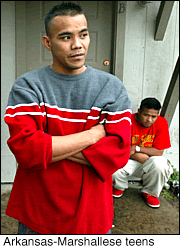 Soon,
Mackphay found Springdale. His aunt, who lived there, had sent a
videotaped message home. Mackphay still recalls the camera panning
over the interior of a fast food restaurant, so neat and clean,
with luxurious tables and chairs. “When I look, I can see nice
clothes. Beautiful car. Beautiful house. I said: ‘Oh man. Maybe
one day if I am going to be there, it will be a different kind of
life,’” he recalled. He saved enough money for a one-way
plane ticket. Soon,
Mackphay found Springdale. His aunt, who lived there, had sent a
videotaped message home. Mackphay still recalls the camera panning
over the interior of a fast food restaurant, so neat and clean,
with luxurious tables and chairs. “When I look, I can see nice
clothes. Beautiful car. Beautiful house. I said: ‘Oh man. Maybe
one day if I am going to be there, it will be a different kind of
life,’” he recalled. He saved enough money for a one-way
plane ticket.
Mackphay, arriving alone in Springdale in 1995, quickly found employment
at a Tyson Foods plant. He eventually rented the apartment and sent
for his wife and two daughters to live with him. His home soon became
a landing pad for other Marshallese moving to the area. Enoch and
his girlfriend moved in because she is the niece of Mackphay’s
wife.
Family ties are so strong on the Marshall Islands that they overwhelm
concerns about personal property or sharing space, said Kiste, the
anthropologist. When the islanders migrate to other countries, the
family ties remain strong. They often depend on relatives for shelter,
food and transportation when arriving somewhere new.
The special U.S. Census survey in 2001 found an average of seven
people living in each Marshallese residence in Springdale. Crowded
conditions in some Springdale residences prompted the City Council
to adopt an ordinance in October that limits the number of occupants
in each dwelling on the basis of the amount of floor space. No one
had been cited for violating the ordinance by year’s end.
Despite crowded conditions by American standards, Marshallese in
Springdale enjoy far more amenities than most of their friends and
relatives have back home. Virtually all of the Arkansas homes have
air conditioning, compared with 30 percent on the islands. They
also have dependable electricity and water 24 hours a day; service
on the islands is spotty.
Like many other Marshallese in Springdale, Mackphay says he probably
will never return home.
If he returned, Mackphay would sink to the bottom of a tribal pecking
order. On the islands, land is owned by a chieftain class called
the “iroij.” Most residents essentially rent the land
they live on from the iroij and support the chiefs with gifts of
money and food.
Born a commoner, Mackphay is now the iroij of Apartment D on Christy
Drive. He no longer works, and during the days is usually asleep
on a pad in the middle of the apartment’s tidy living room.
The walls around him are decorated with hand-woven artwork and portraits
of his family. Back home, Mackphay would stand in line behind half
a dozen siblings to inherit rights to the land his family has used
for generations. “I got too much family back on Majuro,”
he said.
For every Mickey Mackphay who has made it in Springdale, there seems
to be a Gordon Bellu on Majuro hoping to follow him. Bellu says
he gets off of work at 5 p.m. But somehow every night seems to be
an exception. Near 6 o’clock one night in September, he was
stranded on a desolate stretch of road near the Marshall Islands
energy plant. He went there to deliver a rental car and was waiting,
walkie-talkie in hand, for a ride back home. Bellu said he won’t
buy a personal car, though he likely could afford it. He wants to
save his money. “I have to think about getting to the mainland.”
Back To Top
|
 |

 Stories
by Christopher Leonard
Stories
by Christopher Leonard In
many ways, Majuro is like an enormous waiting room whose residents
are stuck between two worlds, having abandoned their old culture
for a modern life that has yet to materialize.
In
many ways, Majuro is like an enormous waiting room whose residents
are stuck between two worlds, having abandoned their old culture
for a modern life that has yet to materialize. Thousands
of Marshallese have made the same choice. Working in chicken plants,
factories and fast-food restaurants, they enjoy a lifestyle that
only a few could afford back home. In Springdale public schools,
their children get a better education than most of the top-ranked
private-schools’ students on the islands.
Thousands
of Marshallese have made the same choice. Working in chicken plants,
factories and fast-food restaurants, they enjoy a lifestyle that
only a few could afford back home. In Springdale public schools,
their children get a better education than most of the top-ranked
private-schools’ students on the islands.  The
streets of Majuro begin to stir just after sunrise. Dented, dusty
taxicabs troll up and down the main road, gathering residents for
their 50-cent rides to work.
The
streets of Majuro begin to stir just after sunrise. Dented, dusty
taxicabs troll up and down the main road, gathering residents for
their 50-cent rides to work. One-way
airfare to Arkansas costs around $1,500, a small fortune for someone
who earns $2 an hour — the minimum wage on the islands. Many
Marshallese take out loans for the trip and send one family member,
who then works in Springdale and saves money to bring the next relative.
Bellu wants to take a different route. “I don’t want to
leave some behind. My kids are not old enough to take care of themselves,
and my wife — I don’t want to leave her. I want us all
to go,” he said.
One-way
airfare to Arkansas costs around $1,500, a small fortune for someone
who earns $2 an hour — the minimum wage on the islands. Many
Marshallese take out loans for the trip and send one family member,
who then works in Springdale and saves money to bring the next relative.
Bellu wants to take a different route. “I don’t want to
leave some behind. My kids are not old enough to take care of themselves,
and my wife — I don’t want to leave her. I want us all
to go,” he said. The
main island of Kwajalein atoll, the largest atoll in the world,
is home to a U.S. Army base that includes the Ronald Reagan Ballistic
Missile Defense Site, a critical component of efforts to build a
missile defense shield. The same remoteness that allows missile
testing played another role in history. On the morning of July 1,
1946, an enormous mushroom cloud rose over the Bikini atoll in the
northwest corner of the Marshall Islands. Over the next 12 years,
the United States detonated 67 atomic or hydrogen bombs in the area.
The tests cost the islanders dearly. Residents of Bikini and nearby
atolls were relocated to other islands and still live in a kind
of exile. Bikini remains uninhabited.
The
main island of Kwajalein atoll, the largest atoll in the world,
is home to a U.S. Army base that includes the Ronald Reagan Ballistic
Missile Defense Site, a critical component of efforts to build a
missile defense shield. The same remoteness that allows missile
testing played another role in history. On the morning of July 1,
1946, an enormous mushroom cloud rose over the Bikini atoll in the
northwest corner of the Marshall Islands. Over the next 12 years,
the United States detonated 67 atomic or hydrogen bombs in the area.
The tests cost the islanders dearly. Residents of Bikini and nearby
atolls were relocated to other islands and still live in a kind
of exile. Bikini remains uninhabited. The
thousands of islanders living in Springdale can trace their passage
directly to one man — John Moody.
The
thousands of islanders living in Springdale can trace their passage
directly to one man — John Moody. Springdale,
meanwhile, was experiencing a boom in industrial jobs at chicken
plants and other factories where English skills weren’t a necessity.
Step by step, Springdale became a sweet spot for Marshallese pursuing
a new life in America. While there were plentiful jobs elsewhere,
Springdale also offered a low cost of living and a slower pace.
In the tightly knit community of islanders, word spread fast about
Springdale’s advantages.
Springdale,
meanwhile, was experiencing a boom in industrial jobs at chicken
plants and other factories where English skills weren’t a necessity.
Step by step, Springdale became a sweet spot for Marshallese pursuing
a new life in America. While there were plentiful jobs elsewhere,
Springdale also offered a low cost of living and a slower pace.
In the tightly knit community of islanders, word spread fast about
Springdale’s advantages. Stevenson
Enoch recently ended his shift around 7 a.m. and walked out of Wal-Mart
into a misty rain. Clouds on the horizon had just started to redden
with the dawn. In some ways, the landscape Enoch saw is similar
to that of his home island. Springdale’s one-story strip malls
and stores form a jagged low skyline not unlike Majuro’s main
street.
Stevenson
Enoch recently ended his shift around 7 a.m. and walked out of Wal-Mart
into a misty rain. Clouds on the horizon had just started to redden
with the dawn. In some ways, the landscape Enoch saw is similar
to that of his home island. Springdale’s one-story strip malls
and stores form a jagged low skyline not unlike Majuro’s main
street. Soon,
Mackphay found Springdale. His aunt, who lived there, had sent a
videotaped message home. Mackphay still recalls the camera panning
over the interior of a fast food restaurant, so neat and clean,
with luxurious tables and chairs. “When I look, I can see nice
clothes. Beautiful car. Beautiful house. I said: ‘Oh man. Maybe
one day if I am going to be there, it will be a different kind of
life,’” he recalled. He saved enough money for a one-way
plane ticket.
Soon,
Mackphay found Springdale. His aunt, who lived there, had sent a
videotaped message home. Mackphay still recalls the camera panning
over the interior of a fast food restaurant, so neat and clean,
with luxurious tables and chairs. “When I look, I can see nice
clothes. Beautiful car. Beautiful house. I said: ‘Oh man. Maybe
one day if I am going to be there, it will be a different kind of
life,’” he recalled. He saved enough money for a one-way
plane ticket.